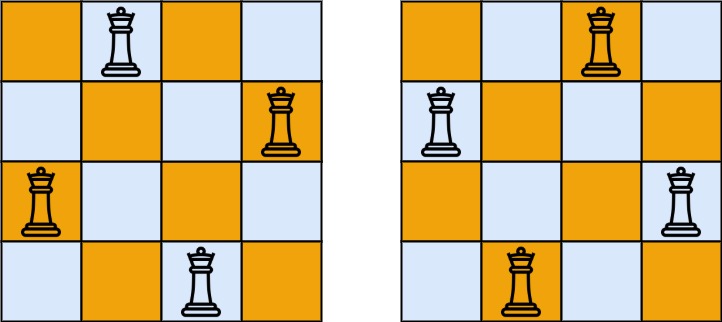LeetCode-in-All
51. N-Queens
Hard
The n-queens puzzle is the problem of placing n queens on an n x n chessboard such that no two queens attack each other.
Given an integer n, return all distinct solutions to the n-queens puzzle. You may return the answer in any order.
Each solution contains a distinct board configuration of the n-queens’ placement, where 'Q' and '.' both indicate a queen and an empty space, respectively.
Example 1:

Input: n = 4
Output: [[“.Q..”,”…Q”,”Q…”,”..Q.”],[”..Q.”,”Q…”,”…Q”,”.Q..”]]
Explanation: There exist two distinct solutions to the 4-queens puzzle as shown above
Example 2:
Input: n = 1
Output: [[“Q”]]
Constraints:
1 <= n <= 9
To solve the “N-Queens” problem in Swift with the Solution class, follow these steps:
- Define a method
solveNQueensin theSolutionclass that takes an integernas input and returns a list of lists of strings. - Initialize a board represented as a 2D character array of size
n x n. Initialize all cells to'.', indicating an empty space. - Define a recursive backtracking function
backtrackto explore all possible configurations of queens on the board. - In the
backtrackfunction:- Base case: If the current row index
rowis equal ton, it means we have successfully placednqueens on the board. Add the current board configuration to the result. - Iterate through each column index
colfrom0ton - 1:- Check if it’s safe to place a queen at position
(row, col)by calling a helper functionisSafe. - If it’s safe, place a queen at position
(row, col)on the board, mark it as'Q'. - Recur to the next row by calling
backtrack(row + 1). - Backtrack: After exploring all possibilities, remove the queen from position
(row, col)by marking it as'.'.
- Check if it’s safe to place a queen at position
- Base case: If the current row index
- In the
solveNQueensmethod, initialize an empty listresultto store the solutions. - Call the
backtrackfunction with initial parameters0for the row index. - Return the
resultlist containing all distinct solutions.
Here’s the implementation of the solveNQueens method in Swift:
public class Solution {
public func solveNQueens(_ n: Int) -> [[String]] {
var pos = [Bool](repeating: false, count: n + 2 * n - 1 + 2 * n - 1)
var pos2 = [Int](repeating: 0, count: n)
var ans = \[\[String]]()
helper(n, 0, &pos, &pos2, &ans)
return ans
}
private func helper(_ n: Int, _ row: Int, _ pos: inout [Bool], _ pos2: inout [Int], _ ans: inout [[String]]) {
if row == n {
construct(n, pos2, &ans)
return
}
for i in 0..<n {
let index = n + 2 * n - 1 + n - 1 + i - row
if pos[i] || pos[n + i + row] || pos[index] {
continue
}
pos[i] = true
pos[n + i + row] = true
pos[index] = true
pos2[row] = i
helper(n, row + 1, &pos, &pos2, &ans)
pos[i] = false
pos[n + i + row] = false
pos[index] = false
}
}
private func construct(_ n: Int, _ pos: [Int], _ ans: inout [[String]]) {
var sol = [String]()
for r in 0..<n {
var queenRow = [Character](repeating: ".", count: n)
queenRow[pos[r]] = "Q"
sol.append(String(queenRow))
}
ans.append(sol)
}
}
This implementation efficiently finds all distinct solutions to the N-Queens problem using backtracking.

